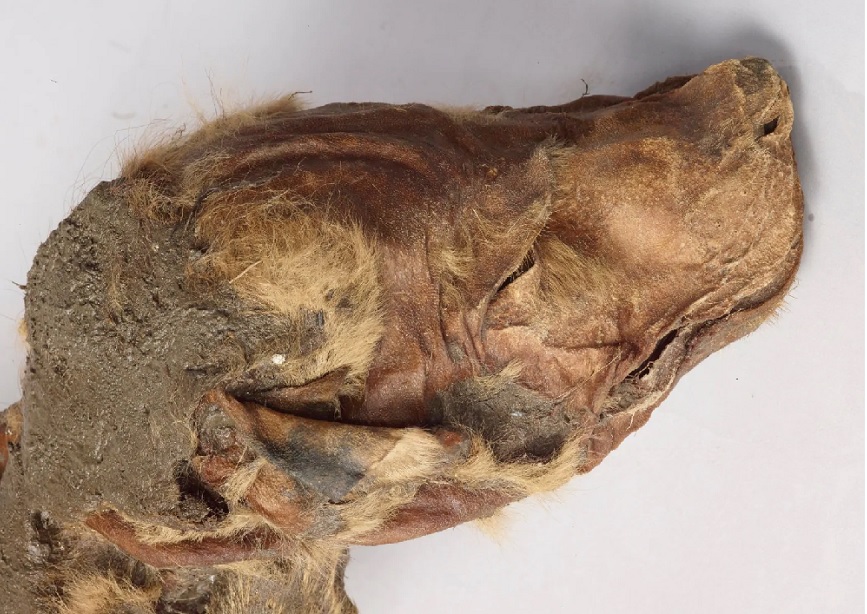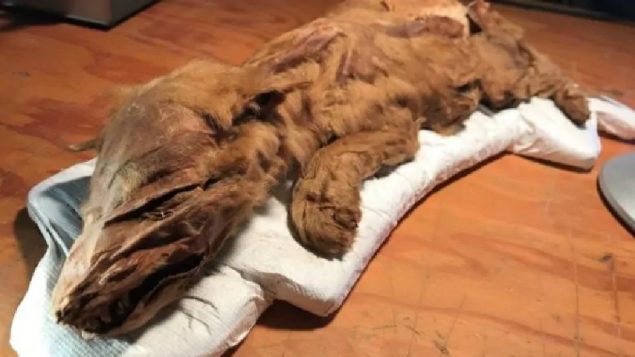It was an unbelievable find.
In July 2016 a gold miner near Dawson City, Yukon, found what he thought was dead puppy. It turned out to be an ice age wolf cub almost perfectly preserved.
Scientists believe the cub was preserved those many thousands of years in ice.
The cub was found by the miner who saw it protruding from thawing permafrost as he was spraying water at a wall of permafrost. Although he thought it might just be an old frozen dog, he put it in his freezer in case until a paleontologist could examine it. It was then determined to be something very special.
It has been under study by experts ever since. They are amazed that the cub still has traces of fur, soft tissue and with internal organs intact.
Julie Meachen, ice-age carnivore morphologist at Des Moines University in the U.S. is leading the research with initial findings published today in the latest issue of Current Biology

Researcher Julie Meachen of Des Moines University, seen here with the cub and veterinarian Jess Heath at a Whitehorse vet clinic in 2019. Heath is one of several co-authors of the new research paper. (Government of Yukon)
Quoted in AAAS Eureka Alert she said, “She’s the most complete wolf mummy that’s ever been found. She’s basically 100% intact–all that’s missing are her eyes. And the fact that she’s so complete allowed us to do so many lines of inquiry on her to basically reconstruct her life.”
They determined the cub was female and only about seven weeks old. They also note that the ice age wolf are not genetically related to modern North American wolves, rather to ice-age wolves in Europe.

Scientists say it took a unique series of circumstances for the pup to be so well preserved (Government of Canada/Canadian Conservation Institute)
While modern wolves hunt caribou, deer, muskox, and moose, the scientists were surprised to discover the cub’s las meal was fish, probably salmon.
The cub was given the name Zhùr, meaning ‘wolf’. in a ceremony with elders First which means “wolf” in the local Indigenous Hän language. Debbie Nagano is the director of heritage for the Tr’ondëk Hwëch’in, and a member of the First Nation’s wolf clan. Quoted in the CBC she said, “We are connected to this wolf pup” adding they worked with scientists to ensure the animal would be treated with respect.
The cub is estimated to be around 57,000 years old, while the first paleo-humans are believed to have entered North American about 40,000 years later, sometime between 20,000 to 14,000 years ago.
The cub will eventually go on display at the Beringia Interpretive Centre in Whitehorse.
While many ancient bones and other specimens are being found as permafrost in the Arctic melts, Meachen quoted in the CBC said she suspects, “other exceptionally-preserved frozen mummies will likely be discovered, providing new windows into the past,”
additional information-sources
- CBC: C Kawaja: Dec 21/20: ‘Kind of incredible’: Researchers uncover details about ice-age wolf pup found in Yukon
- Eureka Alert; dec 21/20: Ancient wolf-pup mummy uncovered in Yukon permafrost
- BBC: Sep 14/16: Mummified ice age wolf pup and caribou found in northern Canada
- Smithsonian Mag: M Solly: Sep 17/18: Gold miners unearth 50,000 year old Caribou calf, wolf pop from Canadian permafrost







For reasons beyond our control, and for an undetermined period of time, our comment section is now closed. However, our social networks remain open to your contributions.